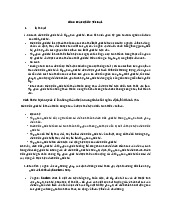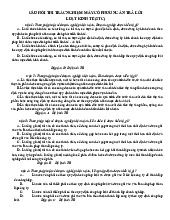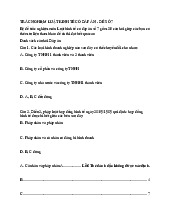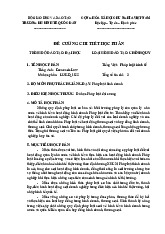











Preview text:
lOMoARcPSD| 38777299
NATIONAL ECONOMIC UNIVERSITY
COURSE: BUSINESS LAW (BLAW220) CASE STUDY 15.8:
EMPLOYMENT, IMMIGRATION AND LABOR LAW - FAMILY
AND MEDICAL LEAVE CASE Table of Contents
I. KNOWLEDGE BACKGROUND OF THE FAMILY AND MEDICAL
LEAVE ....................................................................................................................... 1
1. Definition: .......................................................................................................... 1
2. Coverage and Applicability: ............................................................................ 1
2.1. Coverage: ..................................................................................................... 1
2.2 Applicability:................................................................................................. 1
3. Benefits and Protections: .................................................................................. 2
4. Employee Responsibilities ................................................................................ 2
5. Violations: .......................................................................................................... 3
II.BACKGROUND OF CASE PROBLEMS ......................................................... 3
1.Case summary .................................................................................................... 3
2. Legal Issue ......................................................................................................... 4
III. MAIN ARGUMENT AND ANALYZE ............................................................ 4
1.Contract law ....................................................................................................... 4
2.Plaintiff’s argument: .......................................................................................... 4
3. Defendant’s argument: ..................................................................................... 5
4. Case analyze: ..................................................................................................... 6
5. Court’s Decision ................................................................................................ 7
IV. CONCLUSION ................................................................................................... 8
V. LESSONS AND RELATION TO VIETNAMESE LAW ................................ 9 lOMoARcPSD| 38777299
1. Lessons for employees and business ................................................................ 9
1.1. Lessons for Employees: ............................................................................... 9
1.2. Lessons for Business: .................................................................................. 9
2. Relation to Vietnamese Laws ........................................................................... 10
I. KNOWLEDGE BACKGROUND OF THE FAMILY AND MEDICAL LEAVE 1. Definition:
The Family and Medical Leave Act (FMLA) is a federal law in the United
States that entitles eligible employees of covered employers to take unpaid,
job-protected leave for specified family and medical reasons with
continuation of group health insurance coverage under the same terms and
conditions as if the employee had not taken leave. (U.S Department of Labor)
2. Coverage and Applicability:
2.1. Coverage:
Not all employees are eligible for the FMLA. Employees must work for a
covered organization to take FMLA leave. The FMLA covers: •
Private organizations with at least 50 employees
All government agencies and public and private elementary and secondary schools
Even if the employer is covered by FMLA rules, employees are not
automatically eligible for FMLA leave. All these criteria must be met to qualify for FMLA leave: •
Employees have worked for your employer for at least 12 months. •
Employees have worked at least 1250 hours for your employer in the last 12 months. •
Employer has 50 employees within 75 miles of your worksite.
2.2 Applicability:
An eligible employee may take up to twelve weeks of leave within a
twelvemonth period for any of the following reasons:
• To care for a newborn baby within one year of birth.
• To care for an adopted or foster child within one year of the time the
child is placed with the employee.
• To care for the employee's spouse, child, or parent who has a serious health condition.
• If the employee suffers from a serious health condition and is unable to
perform the essential functions of the job. lOMoARcPSD| 38777299
• For any qualifying exigency (nonmedical emergency) arising out of the
fact that the employee's spouse, son, daughter, or parent is a covered
military member on active duty.
For instance, an employee can take leave to arrange for childcare or to deal
with financial or legal matters when a spouse is being deployed overseas.
3. Benefits and Protections: -
Job Protection: eligible employees who take FMLA leave are
generally entitled to return to their job or an equivalent position when their
leave ends. - Continuation of Benefits: While on FMLA leave, eligible
employees are entitled to maintain their health insurance coverage and other
benefits under the same terms and conditions as if they were actively working. -
Intermittent Leave: In certain situations, employees can take FMLA
leave intermittently, rather than in one continuous block of time. This can be
important when dealing with chronic medical conditions or other situations
that don't require continuous time off.
4. Employee Responsibilities -
Employees must provide 30 days advance notice of the need to take
FMLA leave when the need is foreseeable. When 30 days notice is not
possible, the employee must provide notice as soon as practicable and
generally must comply with an employer’s normal call-in procedures. A call-
in policy, also known as an attendance or reporting policy, is a set of rules
and procedures established by an employer to regulate how employees should
notify the company when they are unable to come to work, will be late, or
need time off. These policies are designed to ensure proper communication
and maintain workforce management. -
Employees must provide sufficient information for the employer to
determine if the leave may qualify for FMLA protection and the anticipated
timing and duration of the leave. Sufficient information may include that the
employee is unable to perform job functions, the family member is unable to
perform daily activities, the need for hospitalization or continuing treatment
by a health care provider, or circumstances supporting the need for military family leave. -
Employees also must inform the employer if the requested leave is for a
reason for which FMLA leave was previously taken or certified. Employees
also may be required to provide a certification and periodic recertification
supporting the need for leave. lOMoARcPSD| 38777299 5. Violations:
An employer that violates the FMLA can be required to provide various
remedies, including the following: •
Damages to compensate an employee for lost benefits, denied
compensation, and actual monetary losses (such as the cost of
providing for care of the family member) up to an amount equivalent to
the employee's wages for twelve weeks (twenty-six weeks for military caregiver leave). • Job reinstatement. •
Promotion, if a promotion has been denied.
A successful plaintiff is also entitled to court costs and attorneys' fees. In
addition, if the plaintiff shows the employer acted in bad faith, the plaintiff
can receive two times the number of damages awarded by a judge or jury.
Supervisors can also be held personally liable, as employers, for violations of the act.
Employers generally are required to notify employees when an absence will
be counted against leave authorized under the act. If an employer fails to
provide such notice, and the employee consequently suffers an injury because
of the lack of notice, the employer may be sanctioned.
II.BACKGROUND OF CASE PROBLEMS 1.Case summary
Plaintiff: Robert Stein - an employee of Atlas Industries, Inc.
Defendant: Atlas Industries, Inc. Situation: •
Stein suffered a knee injury at work and took medical leave to have surgery on his knee. Problems: •
Ten weeks into his recovery, Stein's doctor notified Atlas that he could
return to work with light-duty restrictions in two days without informing Stein. •
Because of the information of the employee's recovery from the doctor,
Atlas expected Stein to return to work, but Stein believed he was on leave for several more weeks.
Decision from the company: •
Atlas had a company policy that allowed them to terminate employees
who missed three workdays without notification. lOMoARcPSD| 38777299 •
Stein did not return to work or call in as Atlas expected, and four days later, he was fired. 2. Legal Issue
In the case of Stein v. Atlas Industries, Inc., the key issue is whether Robert
Stein's discharge violated the Family and Medical Leave Act (FMLA).
III. MAIN ARGUMENT AND ANALYZE 1.Contract law
Contract law is a branch of civil law that focuses on agreements between
individuals or entities, which are legally binding and enforceable. It governs
the creation, enforcement, and interpretation of contracts. A contract is a
legally binding agreement between two or more parties that sets out their
rights and obligations. Contracts can cover a wide range of transactions, from
simple everyday transactions like buying goods at a store to complex business
agreements and international trade deals.
In this case, the actual breach was Robert Stain’s failure to comply with the
company’s call-in policy by not providing the required notice of his absence,
resulting in his automatic termination as per the company’s established
policy. This termination was based on his failure to follow the company’s
usual and customary notice requirements, and it does not appear to be a
violation of the Family and Medical Leave Act (FMLA) if the company’s
policy was applied consistently and in compliance with relevant labor laws.
2.Plaintiff’s argument:
Robert Stein’s potential arguments, as the party bringing the legal action, might include: •
Violation of FMLA Rights: Stein could argue that his termination
violated his rights under the Family and Medical Leave Act (FMLA).
He might claim that he was eligible for FMLA leave due to his knee
injury and that his employer should have provided him with job protection during his leave. •
Lack of FMLA Notice: Stein may assert that his employer failed to
inform him of his FMLA rights and didn't properly designate his
absence as FMLA leave. He might argue that he was unaware of his
entitlement to FMLA protection and that his employer's lack of
communication led to his wrongful termination. •
Failure to Accommodate: If Stein had medical restrictions due to his
knee injury, he could argue that his employer didn't make reasonable lOMoARcPSD| 38777299
accommodations as required by the Americans with Disabilities Act
(ADA) or other applicable laws. He might claim that the company
should have offered him light-duty work or another accommodation. •
Inconsistent Application of Company Policy: Stein could argue that the
company applied its call-in policy inconsistently or unfairly. He may
claim that other employees in similar situations were not terminated or
that the company didn't follow its own policies consistently. •
Lack of Communication: Stein might assert that he attempted to
communicate with the employer regarding his absence or return to
work but was met with obstacles or a lack of response from the
employer. He could argue that he made reasonable efforts to inform the company about his situation.
Stein’s arguments are based on the belief that his termination was unjust and
that it violated his rights under employment and labor laws. His goal in
presenting these arguments would be to seek legal remedies, such as
reinstatement, compensation, or other relief, for what he sees as an unlawful
termination by his former employer.
3. Defendant’s argument:
In this case, where Robert Stein claimed that he was discharged in retaliation
for taking leave under the FMLA, Atlas Industries can present the following arguments: •
Unauthorized Leave: If Stein took leave that was not authorized or
exceeded the leave entitlement provided by the FMLA, Atlas Industries
could argue that his termination was a result of his unauthorized
absence rather than retaliation for FMLA leave. They may assert that
they had a valid reason for the termination, which was unrelated to FMLA. •
Lack of Causation: The defendant might argue that there is insufficient
evidence to establish a direct causal link between Stein's FMLA leave
and his termination. They may claim that the termination was part of a
larger pattern of performance issues, disciplinary actions, or organizational changes. •
Company Policies and Procedures: Atlas Industries may assert that they
followed their established company policies and procedures when
making the decision to terminate Stein. They may argue that their
actions were consistent with their standard HR practices and unrelated
to any FMLA leave-related retaliation. lOMoARcPSD| 38777299
4. Case analyze:
Plaintiff's Perspective (Robert Stein): •
FMLA Retaliation Claim: Robert Stein's primary argument is that he
was terminated in retaliation for taking leave under the Family and
Medical Leave Act (FMLA). He claims that he exercised his legal right
to take FMLA leave due to a medical condition, and the company
responded by terminating his employment, which he views as a
violation of his rights under the FMLA. •
Protected Activity: Stein argues that his FMLA leave is a legally
protected activity, and his termination shortly after taking the leave
suggests a causal connection between his protected activity and the
adverse employment action. He believes that this timing is a crucial
element in demonstrating retaliation. •
Causation and Evidence: Stein aims to establish a strong causal link
between his FMLA leave and termination. He may provide evidence
such as emails, communication records, or witnesses to demonstrate
that his leave was a motivating factor in the termination decision. •
Emotional Distress and Damages: In addition to seeking reinstatement
or compensation for lost wages, Stein may claim emotional distress and
punitive damages if he can prove that Atlas Industries' actions were
willful or in reckless disregard of his FMLA rights.
Defendant's Perspective (Atlas Industries): •
Performance Issues: Atlas Industries argues that Robert Stein's
termination was not related to his FMLA leave but rather to
documented performance issues. They maintain that Stein had a history
of unsatisfactory job performance, including unmet targets and
company policy violations, which led to the termination decision. •
Unauthorized Leave: The defendant may assert that Stein took
unauthorized leave or exceeded his FMLA entitlement, which can be
considered a valid reason for termination. They will likely present
evidence to demonstrate that Stein's leave was not properly requested,
approved, or within the FMLA guidelines. •
Lack of Causation: Atlas Industries contends that there is no direct
causation between Stein's FMLA leave and his termination. They may
argue that Stein's employment issues were part of a larger pattern,
unrelated to the leave he took. •
Company Policies: The defendant claims that they followed their
established company policies and HR procedures when deciding to
terminate Stein. They will argue that the termination was not arbitrary lOMoARcPSD| 38777299
or retaliatory but followed a standard process for addressing
performance and behavior-related concerns. •
Witness Testimonies and Documentation: Atlas Industries may present
witness testimonies, performance evaluations, and communication
records to challenge Stein's version of events and support their own narrative.
In this case, the outcome may depend on the strength of the evidence
presented by both sides, the credibility of witnesses, and the judge or jury's
interpretation of the facts. The key issues revolve around whether Robert
Stein can sufficiently prove FMLA retaliation, and whether Atlas Industries
can demonstrate that the termination was unrelated to his FMLA leave and
based on legitimate business reasons. The court will ultimately make
determination based on the merits of the case and applicable laws.
In our opinions, it does not appear that Robert Stein's discharge violated the
Family and Medical Leave Act (FMLA). The FMLA provides eligible
employees with the right to take up to 12 weeks of unpaid leave for certain
family and medical reasons, including a serious health condition that makes
the employee unable to perform their job. However, to qualify for protection
under the FMLA, employees must comply with their employer's usual and
customary notice requirements, including call-in policies.
In this case, it seems that Atlas Industries, Inc. had a company policy that
required employees to notify the company if they were going to be absent
from work, and that failing to do so for three workdays could lead to
automatic termination. Robert Stein did not return to work or call in as Atlas
expected, and he was terminated four days later. It appears that Atlas
Industries followed their usual and customary notice requirements and
company policy, and Stein did not comply with these requirements.
While Stein may have believed he was on leave for several more weeks, if he
did not communicate this to his employer and follow the company's policies,
he may not be protected under the FMLA. It is essential for employees to
communicate with their employers and follow their established procedures
when requesting and taking FMLA leave to ensure they are protected by the
law. If Stein believes his termination was wrongful, he should consult with an
employment attorney to explore his specific situation further.
5. Court’s Decision
The Court's Ruling in this case was as follows: lOMoARcPSD| 38777299
Firstly, the district court issued a judgment in favor of Atlas Industries,
affirming the principle that employees who are on FMLA leave are required
to comply with their employer's notice and call-in procedures. In other words,
employees enjoying the protections under the Family and Medical Leave Act
must adhere to their employer's established policies for communication during their leave.
Subsequently, the Sixth Circuit Court of Appeals, when reviewing the case,
upheld the district court's decision and further emphasized the obligation
placed on Robert Stein, the plaintiff, to report his intentions regarding
returning to work once his doctor had verified his physical ability to do so.
Essentially, this meant that, according to the court, once Stein's medical
professional confirmed his fitness for duty, he was under a duty to notify his
employer about his work plans.
Moreover, the court ruled against Stein's assertion that he was subjected to
retaliation because of taking FMLA leave. The court's reasoning was
grounded in the fact that the termination occurred after a significant gap of ten
weeks following Stein's initial leave request, leading them to conclude that
the termination was not an immediate response to his request for FMLA protection.
However, and notably, the court did not entirely dismiss Stein's case. It
permitted his legal claim to advance to a jury trial under different legal
grounds, specifically within the framework of the Employee Retirement
Income Security Act (ERISA). This decision was largely based on Atlas
Industries' publicly expressed concerns about the soaring costs of healthcare,
as well as the substantial medical expenses incurred by Stein's family. It
suggested that the termination might be influenced, at least in part, by the
company's desire to alleviate the financial burden caused by these medical costs. IV. CONCLUSION
In summary, the court's ruling dictated that Atlas Industries had not violated
Robert Stein's FMLA rights when they terminated his employment for his
failure to adhere to the company's established policies. Nevertheless, the court
allowed the case to move forward, focusing on the potential claims of
retaliation and interference under ERISA due to the company's expressed
concerns about healthcare costs and the extensive medical expenses incurred by Stein's family. lOMoARcPSD| 38777299
V. LESSONS AND RELATION TO VIETNAMESE LAW
1. Lessons for employees and business
1.1. Lessons for Employees:
Understanding FMLA Protections:
The Family and Medical Leave Act (FMLA) provides crucial protections for
workers who need time off for qualifying medical or family reasons. To fully
grasp the benefits and rights granted under the FMLA, workers should
consider the following key points:
Medical and Family Leave Rights: Workers need to understand that the
FMLA allows them to take unpaid leave for certain qualifying reasons, which
can include their own serious health condition, the care of a spouse, child, or
parent with a serious health condition, or the birth or adoption of a child.
Understanding these rights empowers workers to make informed decisions
about when and how to request FMLA leave.
Protection of Job and Benefits: One of the primary benefits of FMLA is that
eligible employees are entitled to job protection and the maintenance of
certain benefits while on leave. Workers should be aware that they cannot be
terminated or face adverse employment actions due to their FMLA-protected
leave. Additionally, their health insurance and other benefits must be
maintained during the leave period.
Compliance with Call-In Policies:
Understanding and adhering to your company's call-in policies is of
paramount importance, particularly when you are availing FMLA leave or in
urgent situations. Failing to comply with these policies can have undesirable
consequences, such as loss of benefits and misunderstandings with your
employer. Promptly reporting your absence or the need for FMLA leave is
essential. Delays or failure to follow the call-in policy may disrupt work
schedules, create additional stress for colleagues, and lead to
misunderstandings about your availability. Compliance with call-in policies
helps prevent misunderstandings with your employer. It demonstrates your
commitment to fulfilling your job responsibilities and highlights your
professionalism in handling unexpected circumstances.
1.2. Lessons for Business:
Clear Communication and Leave Policies: The lesson for businesses is
about the importance of establishing and enforcing clear leave policies. This lOMoARcPSD| 38777299
includes clear communication of the FMLA sick leave policy and guidance to
employees on how to apply and fulfill notice requirements. A clear policy
helps avoid misunderstandings and conflicts between the company and
employees, while ensuring compliance with legal rights and obligations.
Flexibility and Accommodation for Special Situations: Businesses need to
have flexibility in dealing with special situations, as in the case of FMLA.
Sometimes, situations will require flexibility and understanding to ensure that
workers' rights are not violated for objective reasons.
2. Relation to Vietnamese Laws
According to the article 26 of the Law on Social Insurance (Social Insurance)
2014, employees who suffer from illness or accident and have identified
medical treatment facilities are entitled to rest, affecting the illness regime as follows: * Abnormal cases: -
People working under normal conditions: Get 30 - 60 working days off
depending on the time of social insurance payment. -
People who work in heavy, toxic, dangerous or especially heavy, toxic,
dangerous occupations, or jobs or in places with regional allowance
coefficients of 0.7 or more: 40 - 70 days off optional depending on the insurance payment period.
* In case the disease is on the List of diseases requiring long-term validity:
Employees are entitled to 180 days off/year (including holidays, Tet, and
weekends). If at the end of 180 days you still must continue treatment, you
will be affected in the next pain mode with the maximum level of impact for the current time.
In addition, if the employee wants to take a longer leave from work than the
period covered by the above policy, the employee can agree with the
employer to take unpaid leave.
Pursuant to Clause 3, Article 115 of the 2019 Labor Code, if the employer
agrees, the employee can absolutely leave work for a longer period, (U.S
Department of Labor) but the extended period will not be paid, nor will database billing mechanism.
* In case of sick leave for too long: lOMoAR cPSD| 38777299
To create conditions for companies to be proactive in terms of human
resources in production and business, Clause 1, Article 36 of the 2019 Labor
Code clearly states: The employer has the right to unilaterally terminate the
labor contract in the following cases:
Employees who are sick or have an accident have been treated for 12
consecutive months for those working under an indefinite-term labor contract
or have been treated for 6 consecutive months for those working under a labor
contract. fixed-term employment contract with a term of from 12 months to
36 months or more than half the term of the labor contract for people working
under a fixed-term labor contract with a term of less than 12 months whose
working capacity has not yet returned. When the employee's health recovers,
the employer will consider continuing to enter a labor contract with the employee.
According to this regulation, the company has the right to fire an employee
due to illness if the employee falls into one of the following cases: -
People working under an indefinite-term contract: Sickness has been
treated for 12 consecutive months but the ability to work has not recovered. -
People working under contract from 12 months to 36 months: Sickness has
been treated for 6 consecutive months but the ability to work has not recovered. -
People working under a contract of less than 12 months: Sickness has
been treated for more than half of the contract term but the ability to work has not recovered.
On the contrary, in cases of intermittent or continuous sick leave but not
exceeding the above period, the company is not allowed to unilaterally
terminate the labor contract with that employee. References
U.S Department of Labor. (n.d.). Retrieved from https://www.dol.gov




